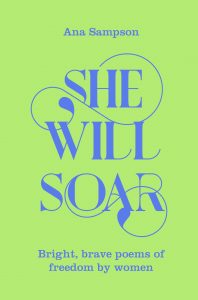She Will Soar: Why Women Write about Escape and Freedom
 My second anthology of poems by women, She Will Soar, aimed again at an 11+ audience as She Is Fierce was, takes as its themes wanderlust, freedom and escape – themes which suddenly took on a strange relevance as I edited the book during lockdown.
My second anthology of poems by women, She Will Soar, aimed again at an 11+ audience as She Is Fierce was, takes as its themes wanderlust, freedom and escape – themes which suddenly took on a strange relevance as I edited the book during lockdown.
I have always believed in books and poetry as magic carpets that can take you anywhere, to places past, present and future, and realms both possible and impossible. Looking at the history of women’s writing, I felt women had particular cause to long to be lifted from their restrictive or humdrum lives by the power of literature.
Women faced certain bars to writing and publishing throughout history, and women who were not white, middle or upper class, heterosexual or helpfully connected had even more stacked against them. Leisure, learning and liberty are key ingredients for any artist, and all have been in shorter supply for women than men throughout history.
Even aristocratic women were usually afforded a rudimentary education compared to their brothers, and none at all in the highfalutin subjects considered ‘proper’ literary subjects: the Classics, theology or blood-drenched battle histories. More recently, the Pulitzer Prize winning poet Sharon Olds was rejected from an American literary magazine for writing about her children: “If you wish to write about this sort of subject, may we suggest the Ladies’ Home Journal”, they acidly suggested.
The role of women was to play muse, not poet. Any who dared pick up a pen themselves faced ridicule, and eighteenth century mothers fretted that their bookish daughters would repel suitors. Women faced condemnation because, in straying into the male arena of literature, it was assumed that they were neglecting their key duties as housewives and mothers.
Anne Bradstreet, the ‘first poet’ of America, had to pretend that her naughty brother-in-law published her work without her knowledge, and he was at pains to include a preface insisting that Anne went without sleep to write rather than slacking in her domestic duties. I found a lot of beautiful nocturnal poems written by women from times past – and couldn’t help but wonder whether this was the only sliver of time they had to themselves, when their large families were finally asleep. It was even more shocking for women to promote their own work… so thrusting! So unseemly!
The job description of the wild and free artist popularised by the Romantics, tramping off to rugged and solitary places, was inaccessible to their female contemporaries. It was difficult to pursue such a path when your corsets conspired against you, you needed a chaperone to cross the road, and nobody had yet invented hiking boots. In the Victorian era, many women, particularly of the middle and upper classes, were almost cloistered in the home. I feel this constraint shows in the melancholy and often morbid notes of much women’s poetry from the period.
Women did write, and women did publish. Through the centuries they resorted to all sorts of strategems, and took advantage where they found it.
Hannah More, born in 1745, funded her literary career with an annual pension from the man who jilted her after a long engagement. Her independence – and freedom from continuous years of childbearing and rearing – enabled her to become a noted philanthropist and lady of letters.
Some published anonymously, others under male or gender neutral pseudonyms. But often, even if they enjoyed great acclaim during their lifetimes, they were forgotten or fell from fashion afterwards. We know that Sappho was hailed as the Tenth Muse of the ancient world, but we have only scraps of her writing now. (It has been suggested that a pope ordered her ‘scandalous’ poetry burnt, but scholars suggest that, in fact, it just wasn’t considered worthy of preservation: a familiar fate for women’s work.)
Aemilia Lanyer, who wrote a daring epic poem that imagined the crucifixion from the point of view of Pontius Pilate’s wife in 1611, was all but forgotten by scholars until she was put forward as a potential model for the ‘Dark Lady’ of Shakespeare’s sonnets.
No wonder women writers longed to spread their wings. And, in verse, they did. From the first African American poet, Phillis Wheatley, to civil rights activists and stars of the Harlem Renaissance such as Georgia Douglas Johnson and Anne Spencer, they wrote uplifting and inspirational poetry.
From women as diverse as the reclusive Emily Dickinson and the inimitable Amy Lowell, who tirelessly promoted the cause of poetry, come poems that shout and shimmy with the delights of freedom. Suffragettes including Emily Wilding Davison and Charlotte Perkins Gilman write passionately about throwing open the door to a new world for women. It’s a pleasure and privilege to collect their words and bring them – I hope – to some new readers, alongside those of some of today’s brightest writing stars.
She Will Soar: Bright, Brave Poems of Freedom by Women, edited by Ana Sampson, is published by Macmillan.
—
Ana Sampson has edited seven poetry anthologies, including I Wandered Lonely as a Cloud (the third best-selling poetry title of 2009), She is Fierce and She Will Soar. She writes and speaks about books, poetry and the hidden history of women’s writing in the media and at bookshops, festivals, libraries, schools and literary events.
You can sign up to my newsletter here
Category: Contemporary Women Writers, On Writing
























